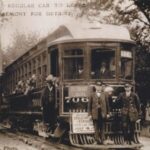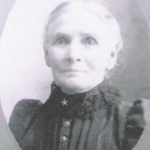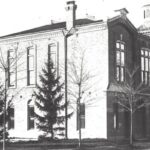Almont’s downtown has experienced many fires since the village was first platted by Daniel Black in 1836.
The first major fire occurred in 1842. The buildings were a mix of log cabins and framed wood structures – no brick buildings. Indications are that the entire business district was destroyed. However, the only written reference to this fire only indicates that the township’s earliest official records were lost in the fire.
Initially, wood framed buildings were used to rebuild the businesses district. In 1848, Daniel Black returned to the village and reacquired a portion of his tavern property and constructed the first brick building in the downtown area and established a mercantile business. This building and the surrounding buildings were destroyed in the next major fire in 1859. This fire did not destroy the entire downtown area – the museum building which was then a law office survived. At this time, little is known about the specifics of this fire.
Again, the business district was rebuilt only to experience another major fire two years later in 1861. Fortunately, this time we have a detailed account of the fire from the Detroit Free Press published on September 22, 1861. It appeared as a “Letter to the Editor”, which was written on September 20th.
The fire began in the Hazen & Harris dry goods store.
Dennison Hazen settled in Macomb County in the 1830s. He married Rhoda Ashley Jennison on March 25, 1835 in Bruce Township of Macomb County. They had three daughters; Elizabeth Danae (1836-1901), Ellen S. (1838-1844), and Lurancy (1841-1844). Ellen and Lurancy died within a month of each other in 1844. Sometime shortly after their deaths, Dennison and Rhoda moved to a farm about three miles east of Almont. Dennison was a prosperous farmer and shoemaker. When a business went up for sale in town, he purchased the business.
He built a small house in town at 322 West St. Clair Street (now in the National Historic District). Probably in Almont, daughter, Elizabeth married John Nelson Harris on May 1, 1856. Both families resided in this small home until “Terrace Place” was completed in 1871. “Terrace Place” is also in the National Historic District and is at 314 West St. Clair Street.
In 1860, Dennison sold the business to his son-in-law and the name was change to Hazen & Harris.
It was a rainy day and the rain was still falling when the fire started about six o’clock in the evening. John Harris went to the back room to draw some kerosene oil for a customer. Due to the time of day and the cloudy conditions outside, the back room was dark, so Mr. Harris took a lamp with him to the back room. He placed the lamp on some stock about two feet from the kerosene barrel. As Mr. Harris opened the spigot to the kerosene barrel, the kerosene gas fumes ignited and the flame immediately spread to the barrel resulting in an explosion. Mr. Harris was instantly covered with flaming oil. He ran out the front door and rolled in the mud and water puddles but before the flames were extinguished, he was severely burned. The editorial indicated that people “despaired for his life”.
The fire quickly spread to nearby buildings. Additional buildings that were destroyed included: the dry goods business of L. Williams in a building owned by E. C. Freeman; William Donelson’s harness shop; Hiram Smith’s tailor shop (located where the Almont Donut and Bakery are today); N. B. Eldridge’s building which housed a bakery and grocery store; and Benjamin Johnson’ cabinet and furniture business.
In the Hazen & Harris building, Justice of the Peace, J. Rattray lost his office and Miss Vail lost her milliners shop.
Several other building, which were in close proximity to the fire, experienced damage but mostly from removing the buildings contents. Next to W. P. Beach’s store was a recently constructed framed building that had just been enclosed. He saved his business by tearing down this structure and putting carpeting soaked with water on his roof.
John Nelson Harris did not die from his burns. He lived for almost another 28 years. He died April 1, 1889 and is buried in Ferguson Cemetery.




